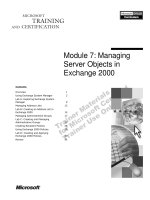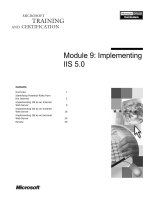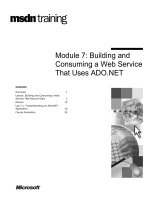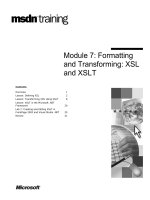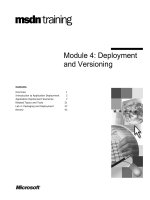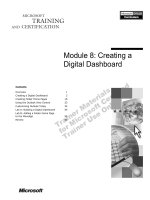Tài liệu Module 9: Creating and Managing Routing Groups in Exchange 2000 ppt
Bạn đang xem bản rút gọn của tài liệu. Xem và tải ngay bản đầy đủ của tài liệu tại đây (1.82 MB, 52 trang )
&RQWHQWV##
2YHUYLHZ#4#
2YHUYLHZ#RI#0HVVDJH#5RXWLQJ#LQ#
([FKDQJH#5333# 5#
5RXWLQJ#*URXSV#7#
&RQQHFWLQJ#5RXWLQJ#*URXSV#;#
/LQN#6WDWH# 48#
+RZ#0HVVDJHV#$UH#5RXWHG# 53#
0DQDJLQJ#5RXWLQJ#*URXSV# 5;#
/DE#$=#&UHDWLQJ#5RXWLQJ#*URXSV#DQG##
5RXWLQJ#*URXS#&RQQHFWRUV# 64#
/DE#%=#&UHDWLQJ#DQ#6073#&RQQHFWRU# 74#
5HYLHZ# 78#
#
Module 9: Creating
and Managing
Routing Groups in
Exchange 2000
Information in this document is subject to change without notice. The names of companies,
products, people, characters, and/or data mentioned herein are fictitious and are in no way intended
to represent any real individual, company, product, or event, unless otherwise noted. Complying
with all applicable copyright laws is the responsibility of the user. No part of this document may
be reproduced or transmitted in any form or by any means, electronic or mechanical, for any
purpose, without the express written permission of Microsoft Corporation. If, however, your only
means of access is electronic, permission to print one copy is hereby granted.
Microsoft may have patents, patent applications, trademarks, copyrights, or other intellectual
property rights covering subject matter in this document. Except as expressly provided in any
written license agreement from Microsoft, the furnishing of this document does not give you any
license to these patents, trademarks, copyrights, or other intellectual property.
2000 Microsoft Corporation. All rights reserved.
Microsoft, MS-DOS, MS, Windows, Windows NT, Active Directory directory service, ActiveX,
BackOffice, FrontPage, Hotmail, MSN, Outlook, PowerPoint, SQL Server, Visual Studios, and
Win32, are either registered trademarks or trademarks of Microsoft Corporation in the U.S.A.
and/or other countries.
The names of companies, products, people, characters, and/or data mentioned herein are fictitious
and are in no way intended to represent any real individual, company, product, or event, unless
otherwise noted.
Other product and company names mentioned herein may be the trademarks of their respective
owners.
Project Lead:
David Phillips
Instructional Designers:
Lance Morrison (Wasser), Janet Sheperdigian, Steve Thues
Lead Program Manager:
Mark Adcock
Program Manager:
Lyle Curry, Scott Hay, Janice Howd, Steve Schwartz (Implement.Com),
Bill Wade (Wadeware LLC)
Graphic Artist:
Kimberly Jackson, Andrea Heuston (Artitudes Layout and Design)
Editing Manager:
Lynette Skinner
Editor:
Elizabeth Reese (Write Stuff)
Copy Editor:
Ed Casper (S&T Consulting), Carolyn Emory (S&T Consulting), Patricia Neff
(S&T Consulting), Noelle Robertson (S&T Consulting)
Online Program Manager:
Debbi Conger
Online Publications Manager:
Arlo Emerson (Aquent Partners)
Online Support:
Eric Brandt
Multimedia Developer
: Kelly Renner (Entex)
Compact Disc Testing:
Data Dimensions, Inc.
Production Support:
Ed Casper (S&T Consulting)
Manufacturing Manager:
Bo Galford
Manufacturing Support:
Rick Terek
Lead Product Manager, Development Services:
Lead Product Manager:
David Bramble
Group Product Manager:
Robert Stewart
# 0RGXOH#<=#&UHDWLQJ#DQG#0DQDJLQJ#5RXWLQJ#*URXSV#LQ#([FKDQJH#5333# # LLL#
,QVWUXFWRU#1RWHV#
This module provides students with knowledge and skills to design, implement,
and manage routing groups. This module explains the message routing
algorithms used in Microsoft
®
Exchange 2000. Routing groups and the link
state table are explained. Various routing scenarios are discussed and analyzed.
At the end of this module, students will be able to:
„#
Describe the components that enable message routing between servers and
routing groups.
„#
Explain what the link state table is and how it is used for message routing.
„#
Describe the routing algorithm used to determine the path for a message.
„#
Design routing groups for a given situation.
„#
Create and manage routing groups and routing group connectors.
0DWHULDOV#DQG#3UHSDUDWLRQ#
This section provides you with the required materials and preparation tasks that
are needed to teach this module.
5HTXLUHG#0DWHULDOV#
To teach this module, you need the following materials:
•
Microsoft PowerPoint
®
file 1569A_09.ppt
3UHSDUDWLRQ#7DVNV#
To prepare for this module, you should:
„#
Read all of the materials for this module.
„#
Complete the lab.
„#
Practice your demonstration.
3UHVHQWDWLRQ=##
453#0LQXWHV#
#
/DE=##
93#0LQXWHV#
LY##0RGXOH#<=#&UHDWLQJ#DQG#0DQDJLQJ#5RXWLQJ#*URXSV#LQ#([FKDQJH#5333#
,QVWUXFWRU#6HWXS#IRU#D#/DE#
This section provides lab tips for labs in this module.
/DE#$=#&UHDWLQJ#5RXWLQJ#*URXSV#DQG#5RXWLQJ#*URXS#
&RQQHFWRUV##
During this lab, problems with Exchange 2000 Beta 3 may cause messages to
become stuck in the Simple Mail Transfer Protocol (SMTP) PreRoutingQueue
in London. Monitor this queue during the lab, and if messages become stuck,
enter the following command in a command prompt window:
.LOO#LQHWLQIR#
#
This is the process that contains SMTP. It will automatically restart and
messages should then flow out of the PreRoutingQueue. You can force the
restart by right-clicking on the PreRoutingQueue, and then clicking Make
Connection Active.
# 0RGXOH#<=#&UHDWLQJ#DQG#0DQDJLQJ#5RXWLQJ#*URXSV#LQ#([FKDQJH#5333# # Y#
0RGXOH#6WUDWHJ\#
Use the following strategy to present this module:
„#
Overview of Message Routing in Exchange 2000
Give an overview of message routing, defining terms and making a clear
distinction from previous versions of Exchange.
„#
Routing Groups
Describe the characteristics of a routing group.
„#
Connecting Routing Groups
List and describe each of the connectors that can be used to connect routing
groups.
„#
Link State
Describe the link state table and how its information is used to determine
message routes.
„#
How Messages Are Routed
Explain how messages are transferred from sender to recipient for a variety
of scenarios. Present each slide, keeping the focus on that specific scenario,
rather than using one slide to explain every scenario.
„#
Designing Routing Groups
Discuss routing group designs, including what servers can be part of a
routing group, when to use multiple routing groups, and how to choose a
connector.
„#
Creating Routing Groups and Routing Group Connectors
Demonstrate how to create a routing group and a routing group connector.
# 0RGXOH#<=#&UHDWLQJ#DQG#0DQDJLQJ#5RXWLQJ#*URXSV#LQ#([FKDQJH#5333# # 4#
2YHUYLHZ#
„
2YHUYLHZ#RI#0HVVDJH#5RXWLQJ#LQ#([FKDQJH#5333
„
5RXWLQJ#*URXSV
„
&RQQHFWLQJ#5RXWLQJ#*URXSV
„
/LQN#6WDWH
„
+RZ#0HVVDJHV#$UH#5RXWHG
„
0DQDJLQJ#5RXWLQJ#*URXSV
Routing groups provide the administrator with a method for controlling
message traffic, tracking messages, and troubleshooting delivery failures. The
link state table provides an efficient method for routing messages and
preventing the ping-pong effect, if a link has failed. With the flexibility comes
additional complexity in planning and properly grouping servers within a
routing group.
At the end of this module, you will be able to:
„#
Describe the components that enable message routing between servers and
routing groups.
„#
Describe requirements for routing groups and when to use multiple routing
groups.
„#
Describe the connectors used to connect routing groups.
„#
Explain what the link state table is and how it is used for message routing.
„#
Describe the routing algorithm that is used to determine the path for a
message.
„#
Create and manage routing groups and routing group connectors.
6OLGH#2EMHFWLYH#
7R#SURYLGH#DQ#RYHUYLHZ#RI#
WKH#PRGXOH#WRSLFV#DQG#
REMHFWLYHV1#
/HDG0LQ#
,Q#WKLV#PRGXOH/#\RX#ZLOO#OHDUQ#
KRZ#URXWLQJ#JURXSV#ZRUN/#
KRZ#WR#SODQ#URXWLQJ#JURXSV/#
DQG#KRZ#WR#FUHDWH#URXWLQJ#
JURXSV#DQG#URXWLQJ#JURXS#
FRQQHFWRUV1#
5# # 0RGXOH#<=#&UHDWLQJ#DQG#0DQDJLQJ#5RXWLQJ#*URXSV#LQ#([FKDQJH#5333#
2YHUYLHZ#RI#0HVVDJH#5RXWLQJ#LQ#([FKDQJH#5333#
Link State
Table
Connector
Routing Group A
Routing Group A
Routing Group B
Routing Group B
The routing process for a message begins when Microsoft
®
Exchange 2000
receives a message either from a user, another computer running Exchange, or a
foreign messaging system through a connector or gateway. The server running
Exchange 2000 looks up the recipient in Active Directory™ directory service
and routes the message to the recipient.
'LIIHUHQFHV#%HWZHHQ#([FKDQJH#5333#DQG#3UHYLRXV#
9HUVLRQV#
Previous versions of Exchange use sites to organize servers for both
communications and administration. Network bandwidth is the primary factor
in determining site boundaries. That is, network bandwidth should be high
between servers within a site. However, a site design based on network
bandwidth may not be the optimum design for administrative boundaries.
With Exchange 2000, the site concept is divided into routing groups and
administrative groups. With Exchange 2000 in native mode, routing group
design is independent of administrative group design.
5RXWLQJ#*URXSV##
Routing groups are groups of servers running Exchange 2000 that are
connected over reliable, permanent links. From a topological perspective,
routing groups are equivalent to sites in previous versions of Exchange.
Separating servers into routing groups enables you to control mail flow,
trouble-shoot message transfer between groups of servers, and track messages.
Exchange 2000 uses Simple Mail Transfer Protocol (SMTP) as its primary
protocol, rather than RPC (Remote Procedure Call), which was used by
previous versions of Exchange. With SMTP, it is not as important to have a
high bandwidth connection between servers. SMTP is more reliable over
limited bandwidth connections than is RPC. It is more important that servers in
a routing group have permanent, reliable connectivity than high bandwidth
between them.
6OLGH#2EMHFWLYH#
7R#SURYLGH#DQ#RYHUYLHZ#RI#
PHVVDJH#URXWLQJ#DQG#WR#
LQWURGXFH#WHUPV#DQG#
FRPSRQHQWV1#
/HDG0LQ#
0HVVDJH#URXWLQJ#LQ#
([FKDQJH#5333#KDV#EHHQ#
RSWLPL]HG#WR#UHGXFH#
PHVVDJH#SLQJ0SRQJ#ZKHQ#D#
VHUYHU#FRQQHFWLRQ#LV#GRZQ1#
# 0RGXOH#<=#&UHDWLQJ#DQG#0DQDJLQJ#5RXWLQJ#*URXSV#LQ#([FKDQJH#5333# # 6#
&RQQHFWRUV#
Routing groups are connected using connectors. Following is a list of
connectors available with Exchange 2000 that can connect routing groups
together:
„#
Routing group connector
„#
Simple Mail Transfer Protocol connector
„#
X.400 connector
Connectors designed for third party mail systems cannot be used to connect
routing groups.
/LQN#6WDWH#
The Exchange 2000 routing and selection process uses a link state table to
determine the shortest path between two routing groups for a given message. To
provide an efficient fault tolerant routing mechanism, Exchange 2000 uses a
link state table. The link state table is stored on each server running
Exchange 2000 and contains the status of each connector in the Exchange 2000
organization. If a server running Exchange 2000 cannot find a route for a
particular message after referring to the link state table, it will not attempt to
deliver the message.
7# # 0RGXOH#<=#&UHDWLQJ#DQG#0DQDJLQJ#5RXWLQJ#*URXSV#LQ#([FKDQJH#5333#
‹‹
#
5RXWLQJ#*URXSV#
„
'HILQLQJ#D#5RXWLQJ#*URXS
„
:KHQ#WR#8VH#0XOWLSOH#5RXWLQJ#*URXSV
„
5RXWLQJ#*URXS#7RSRORJ\
SMTP
A routing group is a group of servers running Exchange 2000 with reliable
connectivity between them. Servers running Exchange 2000 in the same routing
group have full-mesh connectivity, which means that all of the servers in the
routing group communicate directly with each other. They can deliver messages
as needed in a single hop. Servers running Exchange 2000 in the same routing
group are assumed to have reliable, permanent network connectivity between
them.
When you plan your routing topology, you should take into consideration the
physical locations that you have, how they are connected, and whether or not
you want to control message flow. This exercise is similar to designing
Exchange sites in earlier versions of Exchange and similar to designing
Microsoft Windows
®
2000 Active Directory sites.
6OLGH#2EMHFWLYH#
7R#JLYH#DQ#RYHUYLHZ#RI#WKLV#
WRSLF1#
/HDG0LQ#
$#URXWLQJ#JURXS#LV#D#JURXS#RI#
VHUYHUV#WKDW#KDYH#UHOLDEOH/#
SHUPDQHQW#FRQQHFWLYLW\1#
# 0RGXOH#<=#&UHDWLQJ#DQG#0DQDJLQJ#5RXWLQJ#*URXSV#LQ#([FKDQJH#5333# # 8#
'HILQLQJ#D#5RXWLQJ#*URXS#
„
&KDUDFWHULVWLFV#RI#D#6LQJOH#5RXWLQJ#*URXS
z
5HOLDEOH#FRQQHFWLYLW\#EHWZHHQ#VHUYHUV
z
0HVVDJHV#GHOLYHUHG#LQ#D#VLQJOH#KRS
z
1R#VFKHGXOLQJ#RI#PHVVDJH#GHOLYHU\
„
5HTXLUHPHQWV#IRU#6HUYHUV#LQ#WKH#6DPH#5RXWLQJ#*URXS
z
0XVW#EHORQJ#WR#VDPH#$FWLYH#'LUHFWRU\#IRUHVW
z
0XVW#KDYH#SHUPDQHQW#GLUHFW#6073#FRQQHFWLYLW\
z
0XVW#EH#DEOH#WR#FRQQHFW#WR#URXWLQJ#JURXS#PDVWHU
Servers within a single routing group must have permanent connectivity
between them. Messages are delivered in a single hop, immediately, with no
scheduling of message delivery.
Servers within a routing group communicate directly to each other. The
following must apply to servers within the same routing group:
„#
Servers running Exchange must belong to the same Active Directory forest.
„#
Servers running Exchange must have permanent direct SMTP connectivity
to one another.
„#
All servers within a routing group need to be able to contact the routing
group master.
In Exchange 2000 Beta 3, you cannot define a routing group separately
from an administrative group unless you are running in Native mode.
6OLGH#2EMHFWLYH#
7R#SURYLGH#WKH#UHTXLUHPHQWV#
DQG#FRQVLGHUDWLRQV#IRU#
GHILQLQJ#WKH#VHUYHUV#ZLWKLQ#D#
URXWLQJ#JURXS1#
/HDG0LQ#
6HUYHUV#LQ#D#VLQJOH#URXWLQJ#
JURXS#PXVW#PHHW#FHUWDLQ#
UHTXLUHPHQWV1#
1RWH#
9# # 0RGXOH#<=#&UHDWLQJ#DQG#0DQDJLQJ#5RXWLQJ#*URXSV#LQ#([FKDQJH#5333#
:KHQ#WR#8VH#0XOWLSOH#5RXWLQJ#*URXSV##
„
1HWZRUN#&RQQHFWLYLW\#,V#8QUHOLDEOH
z
1HWZRUN#WUDIILF#LV#VDWXUDWHG
z
8QGHUO\LQJ#QHWZRUN#LV#XQVWDEOH
„
:DQW#WR#&RQWURO#WKH#0HVVDJH#3DWK
„
:DQW#WR#6FKHGXOH#7UDQVIHUV#%HWZHHQ#6HUYHUV
Multiple routing groups may be necessary under one or more of the following
conditions:
„#
Network connectivity is unreliable.
•
Network traffic is saturated to the point that communications are not
reliable.
•
The underlying network experiences frequent problems.
„#
You want to control the message paths within an Exchange organization.
For example, the messaging path needs to be altered from single-hop to
multi-hop, such as when servers are located in separate physical locations,
but communicate in a single-hop environment.
„#
You want to schedule messaging between two locations.
If you have a single physical location and all servers are connected through a
reliable, permanent link, you may not require multiple routing groups.
6OLGH#2EMHFWLYH#
7R#GLVFXVV#FRQVLGHUDWLRQV#
IRU#XVLQJ#PXOWLSOH#URXWLQJ#
JURXSV1#
/HDG0LQ#
7KHUH#DUH#VHYHUDO#VLWXDWLRQV/#
ZKLFK#PD\#UHTXLUH#PXOWLSOH#
URXWLQJ#JURXSV1#
# 0RGXOH#<=#&UHDWLQJ#DQG#0DQDJLQJ#5RXWLQJ#*URXSV#LQ#([FKDQJH#5333# # :#
5RXWLQJ#*URXS#7RSRORJ\#
„
0XOWLSOH#3DWKV#$YDLODEOH#%HWZHHQ#5RXWLQJ#*URXSV
„
0HVVDJH#7UDIILF#$QDO\VLV#&DQ#+HOS#'HILQH#%RXQGDULHV
„
$GGLWLRQDO#&RQVLGHUDWLRQV
z
6HUYHU#FRQQHFWLRQV#FDQ#EH#VORZ#DQG#VWLOO#XVH#VLQJOH#
URXWLQJ#JURXS
z
5RXWLQJ#JURXSV#FDQ#EH#FKDQJHG#DIWHU#LQLWLDO#FRQILJXUDWLRQ
z
5RXWLQJ#JURXSV#GHWHUPLQH#SXEOLF#IROGHU#DFFHVV
The link state algorithm solves the problem in previous versions of Exchange of
messages bouncing between sites or connectors while trying to find an open
connection. This improvement provides greater flexibility in designing routing
groups, particularly by allowing multiple paths between routing groups.
0XOWLSOH#3DWKV#$YDLODEOH#%HWZHHQ#5RXWLQJ#*URXSV#
In earlier versions of Exchange, the site topology had to take into account the
possible message ping-pong that would occur if sites had multiple routes
between them. This meant that most site topologies were hub-and-spoke, with
only a single connector between the hub and each spoke. With Exchange 2000
and the link state table, this topology is not necessary because messages are not
bounced back and forth. If a connector fails, the message may be rerouted
through another routing group, but will not bounce back to the original routing
group.
0HVVDJH#7UDIILF#$QDO\VLV#&DQ#+HOS#'HILQH#%RXQGDULHV#
Message traffic analysis can provide helpful information regarding which
servers communicate with each other the most. It can be efficient to include
servers that communicate regularly in the same routing group. However,
designing routing groups solely based on traffic analysis, without regard to
management overhead, may not be the most efficient solution.
$GGLWLRQDO#&RQVLGHUDWLRQV#
Some additional considerations may impact how you design a routing group.
„#
Servers can be connected over slow (but reliable) links as part of the same
routing group.
„#
Routing groups are dynamic, and they can be changed at any time.
„#
The routing group architecture determines public folder access.
6OLGH#2EMHFWLYH#
7R#GLVFXVV#IDFWRUV#WKDW#
DIIHFW#URXWLQJ#JURXS#
WRSRORJ\1#
/HDG0LQ#
([FKDQJH#5333#SURYLGHV#
LQFUHDVHG#IOH[LELOLW\#LQ#
GHVLJQLQJ#URXWLQJ#JURXSV1#
;# # 0RGXOH#<=#&UHDWLQJ#DQG#0DQDJLQJ#5RXWLQJ#*URXSV#LQ#([FKDQJH#5333#
‹‹
#
&RQQHFWLQJ#5RXWLQJ#*URXSV#
„
5RXWLQJ#*URXS#&RQQHFWRU
„
6073#&RQQHFWRU#
„
;1733#&RQQHFWRU#
„
5RXWLQJ#0DLO#WR#$QRWKHU#6\VWHP
Connector
Cost = 10
Routing Group A
Routing Group A
Routing Group B
Routing Group B
Bridgehead
Server
Bridgehead
Server
Communication between servers in different routing groups is accomplished by
using connectors. You can use any of the following connectors to connect two
routing groups:
„#
Routing group connector
„#
SMTP connector
„#
X.400 connector
The Routing Group Connector can only connect routing groups. Other
connectors provide connections to foreign systems in addition to connecting
routing groups within an organization.
When you configure a connector on a server, the connector is included in the
routing process for messages destined outside of the routing group. Servers
running Exchange 2000 that host routing group connectors are called
bridgehead servers. All messages that are delivered between routing groups
pass through the bridgehead server that hosts the routing group connector.
6OLGH#2EMHFWLYH#
7R#SURYLGH#DQ#RYHUYLHZ#RI#
WKLV#WRSLF1#
/HDG0LQ#
7KHUH#DUH#WKUHH#W\SHV#RI#
FRQQHFWRUV#WKDW#FDQ#FRQQHFW#
URXWLQJ#JURXSV1#
# 0RGXOH#<=#&UHDWLQJ#DQG#0DQDJLQJ#5RXWLQJ#*URXSV#LQ#([FKDQJH#5333# # <#
5RXWLQJ#*URXS#&RQQHFWRU#
„
8VHV#6073#7UDQVSRUW#3URWRFRO
„
0XOWLSOH#%ULGJHKHDG#6HUYHUV
„
0HVVDJLQJ#6HFXULW\
„
5HVROYLQJ#7DUJHW#6HUYHU#,3#$GGUHVV
Routing Group
Connector
Bridgehead
Server
Bridgehead
Server
Bridgehead
Server
The routing group connector provides the simplest, easiest way to connect two
routing groups. The routing group connector is similar in function to the Site
Connector in previous versions of Exchange. However, a major difference is
that the routing group connector uses the SMTP message transport protocol
rather than remote procedure calls (RPC) to deliver messages. Benefits of the
routing group connector are:
„#
It is easy to configure.
„#
It can be configured with multiple target bridgehead servers.
„#
It can be used to connect to previous versions of Exchange that are
configured with the Site Connector, which uses RPCs.
0XOWLSOH#%ULGJHKHDG#6HUYHUV#
The routing group connector can be configured with one or more bridgehead
servers on either end of the connector. This allows you to control which servers
send and receive messages between routing groups. An advantage of having
multiple servers identified as bridgehead servers for a routing group connector
is that if a bridgehead server is down, Exchange can choose another bridgehead
server within the routing group to transmit the message.
0HVVDJLQJ#6HFXULW\#
Exchange 2000 provides SMTP authentication between bridgehead servers.
Encryption of messages between bridgehead servers is not enabled by default.
If encryption is required, you can implement IPSec, which is a standard
encryption method for Transmission Control Protocol/Internet Protocol
(TCP/IP) network security. IPSec is available with Windows 2000. However,
messages transferred between servers running Exchange 2000 are in Transport-
Neutral Encapsulation Format (TNEF), and not in plain text.
6OLGH#2EMHFWLYH#
7R#H[SODLQ#WKH#SXUSRVH#DQG#
XVH#RI#WKH#URXWLQJ#JURXS#
FRQQHFWRU1#
/HDG0LQ#
7KH#URXWLQJ#JURXS#FRQQHFWRU#
LV#WKH#VLPSOHVW/#HDVLHVW#ZD\#
WR#FRQQHFW#WZR#URXWLQJ#
JURXSV1#
43# # 0RGXOH#<=#&UHDWLQJ#DQG#0DQDJLQJ#5RXWLQJ#*URXSV#LQ#([FKDQJH#5333#
5HVROYLQJ#WKH#7DUJHW#6HUYHU#,3#$GGUHVV#
When the bridgehead server that hosts the Routing Group Connector receives a
message to be delivered across the connector, the bridgehead server tries to
resolve the target server’s Internet Protocol (IP) address by using the standard
SMTP resolution process. That is, the bridgehead server first tries to resolve the
target server defined on the Routing Group Connector by using Domain Name
System (DNS) mail exchange (MX) records. If no MX records exist for the
target server, which is not unusual, then a DNS query for an A record for the
target server is performed. This means that an A record must exist in DNS for
all servers running Exchange. When the Windows 2000 version DNS is used,
all Windows 2000-based servers, including servers running Exchange 2000,
automatically register A records in DNS.
If, for some reason, an A record for the target server is not found, the
bridgehead server will try to resolve the IP address by using the network basic
input/output system (NetBIOS) name resolution process.
When multiple target servers exist for a Routing Group Connector, then before
SMTP resolves the MX record against a DNS server, Exchange 2000 code
intercepts the request, looks up the bridgehead servers, and returns them to
SMTP.
In short, Exchange performs MX record resolution for SMTP but usually will
resolve the target server by using an A record. This simplifies the configuration
of the Routing Group Connector because an Exchange or a DNS administrator
does not have to create or manage MX records.
In Exchange 2000 Beta 3, NetBIOS name resolution is used to resolve
bridgehead server IP addresses.
1RWH#
# 0RGXOH#<=#&UHDWLQJ#DQG#0DQDJLQJ#5RXWLQJ#*URXSV#LQ#([FKDQJH#5333# # 44#
6073#&RQQHFWRU#
„
%ULGJHKHDG#6HUYHUV
„
5HVROYLQJ#WKH#'HVWLQDWLRQ#6HUYHU#,3#$GGUHVV
z
8VLQJ#D#6PDUW#+RVW
z
5HPRWH#7ULJJHUHG#'HOLYHU\
SMTP
Connector
Bridgehead
Server
Bridgehead
Server
Bridgehead
Server
SMTP connectors can be used to connect routing groups. They should be used
when:
„#
The other side of the connector is the Internet Mail Service (IMS) from
previous versions of Exchange.
„#
When a pull-relationship is required between servers. Where one side
queues messages and the other side pulls them by using the TRN or ETRN
command.
„#
When you want to define Secure Sockets Layer (SSL) or other security
parameters.
%ULGJHKHDG#6HUYHUV#
Each SMTP connector can specify multiple bridgehead servers within each
routing group. All messages from the bridgehead servers to the target routing
group will either be delivered directly after MX resolution by DNS or
forwarded to a smart host.
5HVROYLQJ#WKH#'HVWLQDWLRQ#6HUYHU#,3#$GGUHVV#
The SMTP connector uses the standard method of resolving the destination
server’s IP address through DNS MX records.
That is, the SMTP connector first tries to resolve the destination server by using
DNS MX records. If an MX record does not exist, then the sending server will
attempt to resolve the destination server by using the host name resolution
process, which includes querying DNS for an A record. If the destination server
is still not found, the bridgehead server tries to resolve the IP address by using
the NetBIOS name resolution process.
6OLGH#2EMHFWLYH#
7R#H[SODLQ#WKH#XVH#RI#WKH#
6073#FRQQHFWRU#DV#D#
URXWLQJ#JURXS#FRQQHFWRU1#
/HDG0LQ#
<RX#FDQ#XVH#WKH#6073#
FRQQHFWRU#WR#FRQQHFW#URXWLQJ#
JURXSV1##
)RU#<RXU#,QIRUPDWLRQ#
7KH#JUDSKLF#RQ#WKLV#VOLGH#LV#
DOPRVW#LGHQWLFDO#WR#WKH#
JUDSKLF#RQ#WKH#URXWLQJ#JURXS#
FRQQHFWRU#VOLGH1#,W#VKRZV#
WKDW#ERWK#W\SHV#RI#
FRQQHFWRUV#DOORZ#PXOWLSOH#
EULGJHKHDG#VHUYHUV#SHU#
FRQQHFWRU1#
45# # 0RGXOH#<=#&UHDWLQJ#DQG#0DQDJLQJ#5RXWLQJ#*URXSV#LQ#([FKDQJH#5333#
When multiple target servers exist for an SMTP connector, Exchange 2000
code intercepts the request, looks up the target servers, and returns them to
SMTP before SMTP resolves the MX record against a DNS server.
With an SMTP connector, you can optimize the message transport to a greater
extent than with a Routing Group Connector. SMTP connector options include
authenticating remote domains before sending mail, designating specific times
when mail can be sent, and setting multiple permission levels for multiple users
on the connector.
When creating an SMTP connector, there are three important considerations.
8VLQJ#D#6PDUW#+RVW#RU#'16#5HVROXWLRQ#RI#0;#5HFRUGV#
A smart host is an intermediary host that uses DNS to resolve the destination
host’s IP address and then sends the message to the destination host. The smart
host server must be able to process mail for the remote address space or routing
group that the SMTP connector needs to reach. The SMTP connector relays all
messages through the smart host, which passes them on to the remote
destination by using DNS.
A smart host is helpful for messages traveling between servers over the
Internet, such as when the remote domain can only be reached during certain
times or infrequently. Instead of repeatedly contacting the domain until a
connection is made, the server running Exchange only needs to transmit to the
smart host. Then the smart host makes the remote connection.
If a smart host is not designated, a DNS lookup will be made on every address
to which the SMTP connector sends e-mail.
If you use an IP address to identify the smart host, enclose the address in
brackets ([ ]) to increase system performance. The SMTP service first checks
for a server name, then an IP address. The brackets identify the value as an IP
address, so that the DNS lookup is bypassed.
5HPRWH#7ULJJHUHG#'HOLYHU\#
You can configure the SMTP connector to retrieve queued e-mail from a
remote SMTP server at specified intervals. That is, a remote domain can be
configured to receive and hold e-mail on behalf of the destination domain.
Messages sent to the remote domain are held until the SMTP ETRN command
is received from an authorized account on your local server running Exchange.
The ETRN command can also be used to dequeue e-mail. Select the Request
that remote servers dequeue mail at these times check box, then select the
times that you want the SMTP connector to contact the remote domain and
trigger the delivery of queued mail.
1RWH#
# 0RGXOH#<=#&UHDWLQJ#DQG#0DQDJLQJ#5RXWLQJ#*URXSV#LQ#([FKDQJH#5333# # 46#
;1733#&RQQHFWRU#
„
8VHG#WR#&RQQHFW#WKH#([FKDQJH#6\VWHP#WR#D#/HJDF\#
6\VWHP
„
5HTXLUHV#D#&RQQHFWRU#LQ#%RWK#5RXWLQJ#*URXSV#WR#&UHDWH#
7ZR0:D\#&RQQHFWLRQ
X.400
Connectors
Cost = 10
Cost = 20
You can use an X.400 connector to establish an X.400 messaging route between
two routing groups or between a routing group and an X.400 system. An X.400
messaging route defines the path that an X.400 message follows to reach its
final destination.
Use the X.400 connector to connect routing groups in the following situations:
„#
When the network connection between routing groups is X.25.
„#
When the network connection between routing groups is over Remote
Access Service (RAS).
You can configure multiple X.400 connectors, each using different transport
stacks, such as X.25, Transport Control Protocol (TCP), or remote access
functionality. To connect two routing groups, you must configure X.400
connectors in both routing groups to create a two-way connection.
To provide load balancing and fault tolerance between two routing groups with
the X.400 connector you need to configure multiple connectors.
6OLGH#2EMHFWLYH#
7R#H[SODLQ#WKH#XVH#RI#WKH#
;1733#FRQQHFWRU#LQ#
([FKDQJH#53331#
/HDG0LQ#
<RX#FDQ#XVH#DQ#;1733#
FRQQHFWRU#WR#FRQQHFW#URXWLQJ#
JURXSV#LQ#DGGLWLRQ#WR#
H[WHUQDO#FRQQHFWLRQV1#
47# # 0RGXOH#<=#&UHDWLQJ#DQG#0DQDJLQJ#5RXWLQJ#*URXSV#LQ#([FKDQJH#5333#
5RXWLQJ#0DLO#WR#$QRWKHU#6\VWHP#
„
0DLO#WR#)RUHLJQ#6\VWHPV#5HTXLUHV#D#&RQQHFWRU#IRU#WKDW#
6\VWHP
„
7KH#5RXWLQJ#*URXS#&RQQHFWRU#'RHV#1RW#3URYLGH#
&RQQHFWLYLW\#2XWVLGH#WKH#([FKDQJH#2UJDQL]DWLRQ
„
2WKHU#&RQQHFWRUV
z
6073#FRQQHFWRU#
z
;1733#FRQQHFWRU#
z
/RWXV#1RWHV
z
060DLO
z
FF=0DLO
Exchange offers several ways to route mail to people outside of your company
or to mail systems other than Exchange. You can route mail to SMTP recipients
over the Internet or to X.400 recipients through an X.400 provider.
In addition, you can use the following connectors to connect to a non-Exchange
systems:
„#
Lotus Notes
„#
MSMail
„#
cc:Mail
„#
GroupWise
If Exchange 2000 does not provide a connector for a non-Exchange
system, such as Profs, but such a connector is offered by a legacy Exchange
system, you can use that connector by establishing a legacy Exchange site that
hosts the connector in the Exchange 2000 organization.
6OLGH#2EMHFWLYH#
7R#H[SODLQ#KRZ#PDLO#LV#
URXWHG#WKURXJK#RWKHU#
FRQQHFWRUV1#
/HDG0LQ#
,I#\RX#QHHG#WR#URXWH#PDLO#
RXWVLGH#WKH#([FKDQJH#
RUJDQL]DWLRQ/#\RX#QHHG#DW#
OHDVW#RQH#FRQQHFWRU#LQ#WKH#
RUJDQL]DWLRQ#WKDW#FDQ#
FRQQHFW#WR#WKH#IRUHLJQ#
V\VWHP1#
1RWH#
# 0RGXOH#<=#&UHDWLQJ#DQG#0DQDJLQJ#5RXWLQJ#*URXSV#LQ#([FKDQJH#5333# # 48#
‹‹
#
/LQN#6WDWH#
„
/LQN#6WDWH#7DEOH
„
/LQN#6WDWH#$OJRULWKP
„
+RZ#WKH#/LQN#6WDWH#,V#0DLQWDLQHG
Like Exchange Server 5.x, Exchange 2000 determines the route that a message
will take based on a least cost algorithm. However, a server running
Exchange 2000 also has a map of the entire messaging topology of which it is a
member. This map, represented in what is called the link state table, is updated
regularly and propagated among all the servers so that each server can
determine not only the cheapest way to deliver a message, it can also determine
whether all of the connectors that make up the route are functioning.
6OLGH#2EMHFWLYH#
7R#SURYLGH#DQ#RYHUYLHZ#RI#
WKLV#WRSLF1#
/HDG0LQ#
([FKDQJH#5333#LPSOHPHQWV#
D#OLQN#VWDWH#WDEOH#WR#WUDFN#
URXWLQJ#JURXS#FRQQHFWLRQV1#
49# # 0RGXOH#<=#&UHDWLQJ#DQG#0DQDJLQJ#5RXWLQJ#*URXSV#LQ#([FKDQJH#5333#
/LQN#6WDWH#7DEOH#
„
/LQN#6WDWXV#
z
832'2:1#SHU#FRQQHFWLRQ
„
5RXWLQJ#*URXS#0DVWHU#0DLQWDLQV#/LQN#6WDWH#7DEOH
z
2QH#SHU#URXWLQJ#JURXS
z
)LUVW#VHUYHU#LQ#URXWLQJ#JURXS/#E\#GHIDXOW
z
&RQILJXUDEOH#E\#DGPLQLVWUDWRU
z
%ULGJHKHDG#VHUYHUV#SURSDJDWH#FKDQJHV#WR#RWKHU#URXWLQJ#
JURXSV
Exchange 2000 builds upon the routing architecture in previous versions of
Exchange Server where the available routes and costs in the organization are
available to any messaging server. The link state table replaces the gateway
address resolution table and adds additional functionality.
/LQN#6WDWXV#
There are only two states for any given link: UP or DOWN; so connection
information, such as whether a link is active or in a retry state, is not propagated
and is only known on the server involved in the message transfer.
5RXWLQJ#*URXS#0DVWHUV#
The administrator designates a server to be the routing group master for a
routing group. The routing group master maintains link state information
received from different sources. The routing group master tracks this data and
propagates it to the rest of the servers within the routing group. The first server
added to a routing group becomes the routing group master, but this can be
changed through the Exchange System Manager console.
If the routing group master fails, an administrator must designate a new routing
group master. The servers running Exchange 2000 in the routing group will
continue to use the existing link state table, without updates, until the original
routing group master returns or a new routing group master is designated.
The status of connectors can be viewed from the Exchange System
Manager, under Tools, Monitors.
6OLGH#2EMHFWLYH#
7R#SURYLGH#WKH#
FKDUDFWHULVWLFV#RI#WKH#OLQN#
VWDWH#WDEOH1#
/HDG0LQ#
7KHUH#LV#RQH#OLQN#VWDWH#WDEOH#
IRU#DQ#([FKDQJH#5333#
RUJDQL]DWLRQ1#
1RWH#
# 0RGXOH#<=#&UHDWLQJ#DQG#0DQDJLQJ#5RXWLQJ#*URXSV#LQ#([FKDQJH#5333# # 4:#
/LQN#6WDWH#$OJRULWKP#
„
8VHV#&RVWV#DQG#&RQQHFWLRQ#,QIRUPDWLRQ#WR#'HWHUPLQH#
6KRUWHVW#3DWK#IURP#6RXUFH#WR#'HVWLQDWLRQ
„
'\QDPLFDOO\#8SGDWHV#/LQN#6WDWH#7DEOH#7R#(QVXUH#
0HVVDJHV#$UH#1RW#6HQW#,I#D#&RQQHFWLRQ#,V#'RZQ
Although Exchange 2000 continues to use routes and costs, a link propagation
protocol, called the link state algorithm, has been implemented. The link state
algorithm is responsible for propagating the state of the messaging system in
almost real-time to all servers running Exchange 2000. This has the following
advantages:
„#
Each server running Exchange makes the best routing choice at the time it
receives a message, by using the latest information from the link state table,
so that messages are not sent along a path where a link may have failed.
„#
The link state algorithm eliminates message bounce between servers,
because each server running Exchange 2000 knows whether other alternate
or redundant links are UP or DOWN.
„#
The link state algorithm overcomes message ping-pong problems.
6OLGH#2EMHFWLYH#
7R#GHVFULEH#WKH#OLQN#VWDWH#
DOJRULWKP1#
/HDG0LQ#
7KH#OLQN#VWDWH#DOJRULWKP#
XVHV#WKH#LQIRUPDWLRQ#LQ#WKH#
OLQN#VWDWH#WDEOH#WR#GHWHUPLQH#
WKH#EHVW#URXWH#IRU#D#
PHVVDJH1#
4;# # 0RGXOH#<=#&UHDWLQJ#DQG#0DQDJLQJ#5RXWLQJ#*URXSV#LQ#([FKDQJH#5333#
+RZ#WKH#/LQN#6WDWH#7DEOH#,V#0DLQWDLQHG#
Routing Group
Master
Routing Group
Master
Routing Group
Master
Port 25
3044
3044
3044
If a connection fails between two routing groups, the link state table needs to be
updated and all servers in the organization need to be notified.
/LQN#6WDWH#3URSDJDWLRQ#
Link state data is propagated between routing groups through SMTP on port 25,
and within the routing group using TCP port 3044. If connection status changes,
the link state table is updated as follows:
1. The bridgehead server with the new connection status marks the connector
as UP or DOWN in the link state table.
2. The bridgehead server updates the routing group master over TCP port
3044.
3. The routing group master updates its link state table and updates all of the
other servers running Exchange 2000 in the routing group over TCP port
3044.
4. All other bridgehead servers in the routing group update the routing groups
to which they are connected over TCP port 25.
5. Those bridgehead servers update their routing group masters over TCP port
3044, and so on until all routing groups have been updated.
The link state status is transferred by using an SMTP command rather than a
message. Therefore, status updates cannot be lost.
6OLGH#2EMHFWLYH#
7R#H[SODLQ#KRZ#GDWD#LQ#WKH#
OLQN#VWDWH#WDEOH#LV#XSGDWHG1#
/HDG0LQ#
:KHQHYHU#D#FKDQJH#RFFXUV#
LQ#WKH#VWDWXV#RI#D#
FRQQHFWLRQ/#WKDW#FKDQJH#LV#
SURSDJDWHG#WKURXJKRXW#DOO#RI#
WKH#VHUYHUV#UXQQLQJ#
([FKDQJH#LQ#WKH#
RUJDQL]DWLRQ1#
'HOLYHU\#7LS#
,Q#WKH#DQLPDWLRQ/#WKH#LQLWLDO#
JUDSKLF#VKRZV#WZR#
FRQQHFWRUV#EHWZHHQ#WKUHH#
URXWLQJ#JURXSV1#7KH#HIIHFW#RI#
HDFK#PRXVH#FOLFN#LV#DV#
IROORZV=#
4,#$#FRQQHFWLRQ#LV#EURNHQ#
DQG#WKH#ORFDO#EULGJHKHDG#
PDNHV#WKH#FKDQJH#LQ#LWV#OLQN#
VWDWH#WDEOH1#
5,#7KH#ORFDO#EULGJHKHDG#
VHUYHU#XVHV#SRUW#6377#WR#
QRWLI\#WKH#URXWLQJ#JURXS#
PDVWHU1#
6,#7KH#URXWLQJ#JURXS#PDVWHU#
QRWLILHV#VHUYHUV#LQ#WKH#
URXWLQJ#JURXS#XVLQJ#SRUW#
63771#
7,#%ULGJHKHDG#VHUYHUV#
FRPPXQLFDWH#WKH#FKDQJH#WR#
UHPRWH#URXWLQJ#JURXSV#XVLQJ#
3RUW#581#
8,#7KH#UHPRWH#URXWLQJ#JURXS#
VHUYHUV#DUH#XSGDWHG1#
# 0RGXOH#<=#&UHDWLQJ#DQG#0DQDJLQJ#5RXWLQJ#*URXSV#LQ#([FKDQJH#5333# # 4<#
5HFRYHULQJ#D#&RQQHFWLRQ#
When a connection fails, the bridgehead server with the failed connector
continues to retry the connection at 60 second intervals. This interval cannot be
configured.
Although messages have been rerouted, the bridgehead server continues to try
to open port 25 on the destination server. After a connection is re-established,
the bridgehead server notifies the local routing group master that the connection
is available. The routing group master, in turn, notifies all of the servers in the
routing group that the connection is available. Finally, all bridgehead servers in
the routing group notify the bridgehead servers to which they are connected in
adjacent routing groups.

